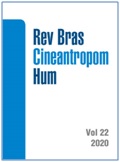Acute effects of graduated compression stockings on oxidative stress and muscle damage markers in garbage collectors: a randomized, crossover-controlled trial
DOI:
https://doi.org/10.1590/%25xResumen
Intense physical activity can increase oxidative stress and muscle damage in, causing fatigue and injury. Graduated compression stockings (GCS) can decrease these deleterious effects. The aim was to determine the acute effects of GCS on muscle damage and oxidative stress (OS) in garbage collectors. Thirteen garbage collectors, 25.4±5.2 years, participated using GCS or placebo stockings. Blood samples were collected at pre and post a working day and after 16 hours of rest. Markers of OS and muscle damage were evaluated. Two-way ANOVA (two conditions and two moments) was used for the analysis of the outcomes No significant differences were found for creatine kinase, catalase and glutathione peroxidase between the time and groups. There was a significant difference for the total thiol content and superoxide dismutase only in the control group (pre and post, p = 0.004). The use of GCS exerted acute protection against the increase of markers of OS, but did not contribute to attenuate muscle damage.
Citas
Cardoso RK, Rombaldi AJ, Silva MC. Osteomuscular disorders and associated factors among solid waste collectors of two middle-sized cities from the South of Brazil. Rev Dor 2014; 15(1):13-16.
Cruzat VF, Rogero MM, Borges MC, Tirapegui J. Current aspects about oxidative stress, physical exercise and supplementation. Rev Bras Med Esporte 2007; 13(5):336-42.
Kraemer WJ, Bush JA, Wickham RB, Denegar CR, Gomes AL, Gosthalk LA, et al. Continuous compression as an effective therapeutic intervention in treating eccentric-exercise-induced muscle soreness. J Sport Rehabil 2001; 10: 11-23.
Miyamoto N, Hirata K, Mitsukawa N, Yanai T, Kawakami Y. Effect of pressure intensity of graduated elastic compression stocking on muscle fatigue following calf-raise exercise. J Electromyogr Kinesiol 2011; 21(2):249-54.
Bieuzen F, Brisswalter J, Easthope C, Vercruyssen F, Bernard T, Hausswirth C. Effect of wearing compression stockings on recovery after mild exercise-induced muscle damage. Int J Sports Physiol Perform 2014; 9: 256 –264, 2014.
Vasconcelos RC, Lima FPA, Camarotto JA, Abreu ACMS, Coutinho Filho AOS. Aspects of the complexity of domestic waste collection: management of street work variability. Gest Prod 2008; 15:407-19.
Machado CN, Gevaerd MS, Goldfeder RT, Carvalho T. Exercise effects on serum levels of creatine kinase in ultradistance triathletes in the course of a competition period. Rev Bras Med Esporte 2010; 16(5):378-81.
Aguiló A, Tauler P, Fuentespina E, Tur JA, Córdova A, Pons A. Antioxidant response to oxidative stress induced by exhaustive exercise. Physiol Behav 2005; 84 (1):1-7.
Fleck MPA. The World Health Organization instrument to evaluate quality of life (WHOQOL-100): characteristics and perspectives. Cienc Saúde Coletiva 2000; 5(1):33-8.
Esterbauer H, Cheeseman KH. Determination of aldehydic lipid peroxidation products: malonaldehyde and 4-hydroxynonenal. Methods Enzymol 1990; 186:407-21.
Aksenov MY, Markesbery WR. Changes in thiol content and expression of glutathione redox system genes in the hippocampus and cerebellum in Alzheimer’s disease. Neurosci Lett 2001; 302(2/3):141-45.
Misra HP, Fridovich I. The role of superoxide anion in the autoxidation of epinephrine and a simple assay for superoxide dismutase. J Biol Chem 1972; 247(10):3170-5.
Aebi H. Catalase in vitro. Methods Enzymol 1984; 105:121-6.
Duffield R, Portus M. Comparison of three types of full-body compression garments on throwing and repeat-sprint performance in cricket players. Rev Bras Med Esporte 2007; 41:409-14.
Ali A, Creasy RH, Edge JA. Physiological effects of wearing graduated compression stockings during running. Eur J Appl Physiol 2010; 109:1017-25.
Clarkson PM, Hubal MJ. Exercise-induced muscle damage in humans. American Am J Phys Med Rehabil 2002; 8(11):52-69.
Neal RC, Ferdinand KC, Ycas J, Miller E. Ethnicity, Gender, Age, and creatine kinase levels. Am J Med 2009; 122(1):73-8.
BanfI G, Colombini A, Lombardi G, Lubkowska A. Metabolic markers in sports medicine. Adv Clin Chem 2012; 56:1-54.
Finaud J, Scislowski V, Lac G, Durand D, Vidalin H, Robert A. Antioxidant status and oxidative stress in professional rugby players: evolution throughout a season. Int J Sports Med 2006; 7(2):87-93.
Powers SK, Talbert EE, Adhihetty PJ. Reactive oxygen and nitrogen species as intracellular signals in skeletal muscle. J Physiol 2011; 589(9):2129-38.
Vincent HK, Powers SK, Demirel HA, Coombes JS, Naito H. Exercise training protects against contraction induced lipid peroxidation in the diaphragm. Eur J Appl Physiol Occup Physiol 1999; 79(3): 268-273.
Powers SK, Lennon SL. Analysis of cellular responses to free radicals: focus on exercise and skeletal muscle. P Nutr Soc. 1999; 58: 1025–1033.
Brites FD, Evelson PA, Christiansen MG, Nicol MF, Basílico MJ, Wikinski RW, Llesuy SF. Soccer players under regular training show oxidative stress but an improved plasma antioxidant status. Clin Sci 1999; 96(4):381-85.
Sen CK, Packer L. Thiol homeostasis and supplements in physical exercise. Am J Clin Nutr 2000; 72 (suppl): 653-69.
Quindry JC, Stone WL, King J, Broeder CE. The effects of acute exercise on neutrophils and plasma oxidative stress. Med Sci Sports Exerc 2006; 35:1139-45.
Schneider CD, Silveira MM, Moreira JCF, Belló-Klein A, Olliveira AR. Effect of the ultra-endurance exercise on oxidative stress parameters. Rev Bras Med Esporte 2009; 1; 5:89-92.
Powers SK, Ji LL, Leeuwenburgh C. Exercise training-induced alterations in skeletal muscle antioxidant capacity: a brief review. Med Sci Sports Exerc 1999; 3:987-97.
Djordjevic DZ, Cubrilo DG, Puzovic ZS, Vuletic MS, Zivkovic NS, Barudzik NS, et al. Changes in athlete's redox state induced by habitual and unaccustomed exercise. Oxid Med Cell Longev 2012;2012:805850
Groussard C, Rannou-Bekono F, Machefer G, Chevanne M, Vicent S, Sergent O, et al. Changes in blood lipid peroxidation markers and antioxidants after sprint anaerobic exercise. Eur J Appl Physiol. 2013; 89:14-20.
Descargas
Publicado
Número
Sección
Licencia

Direitos Autorais para artigos publicados nesta revista são do autor, com direitos de primeira publicação para a revista. Em virtude da aparecerem nesta revista de acesso público, os artigos são de uso gratuito, com atribuições próprias, em aplicações educacionais e não-comerciais, desde que seja dada a atribuição. Esta obra foi licenciada com uma Licença Creative Commons Atribuição 4.0 Internacional - CC BY


